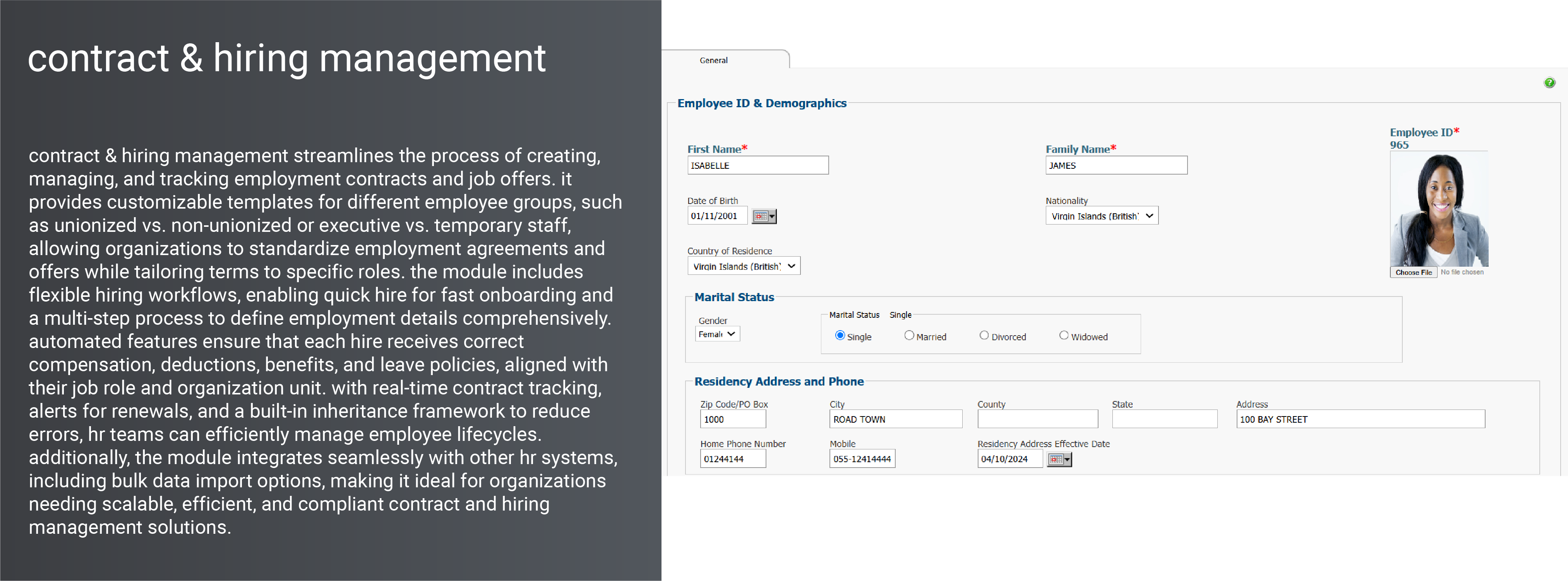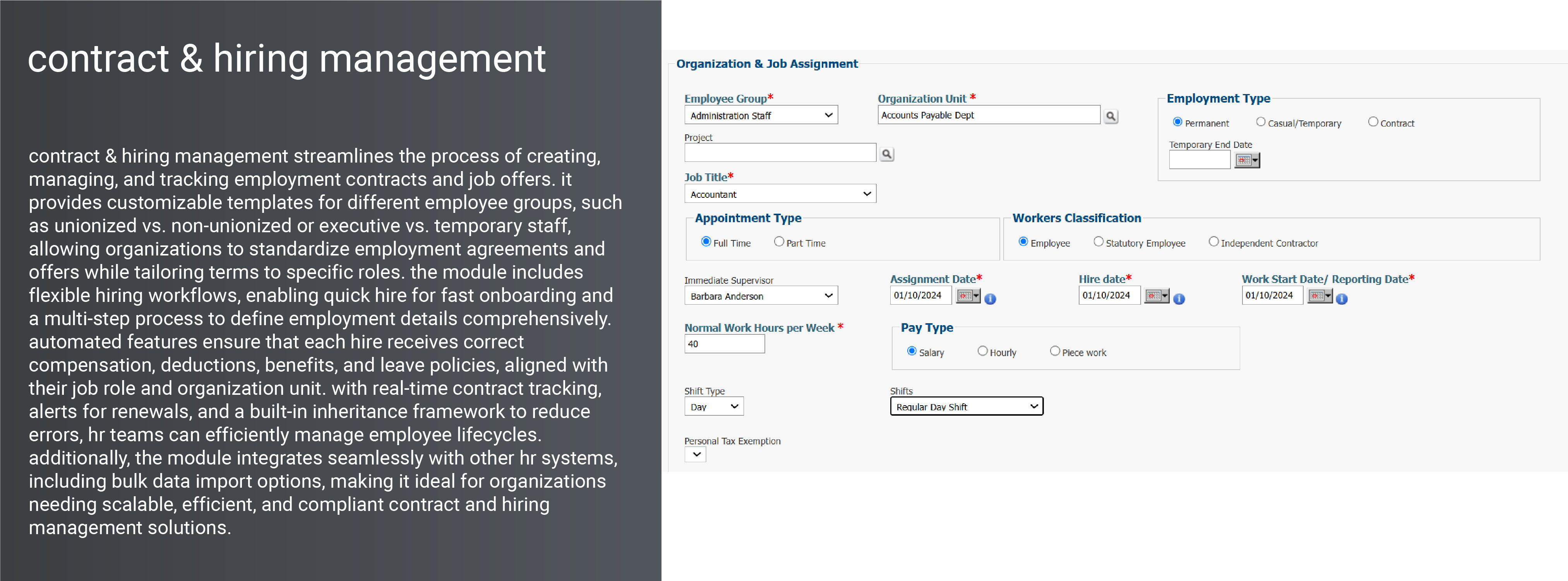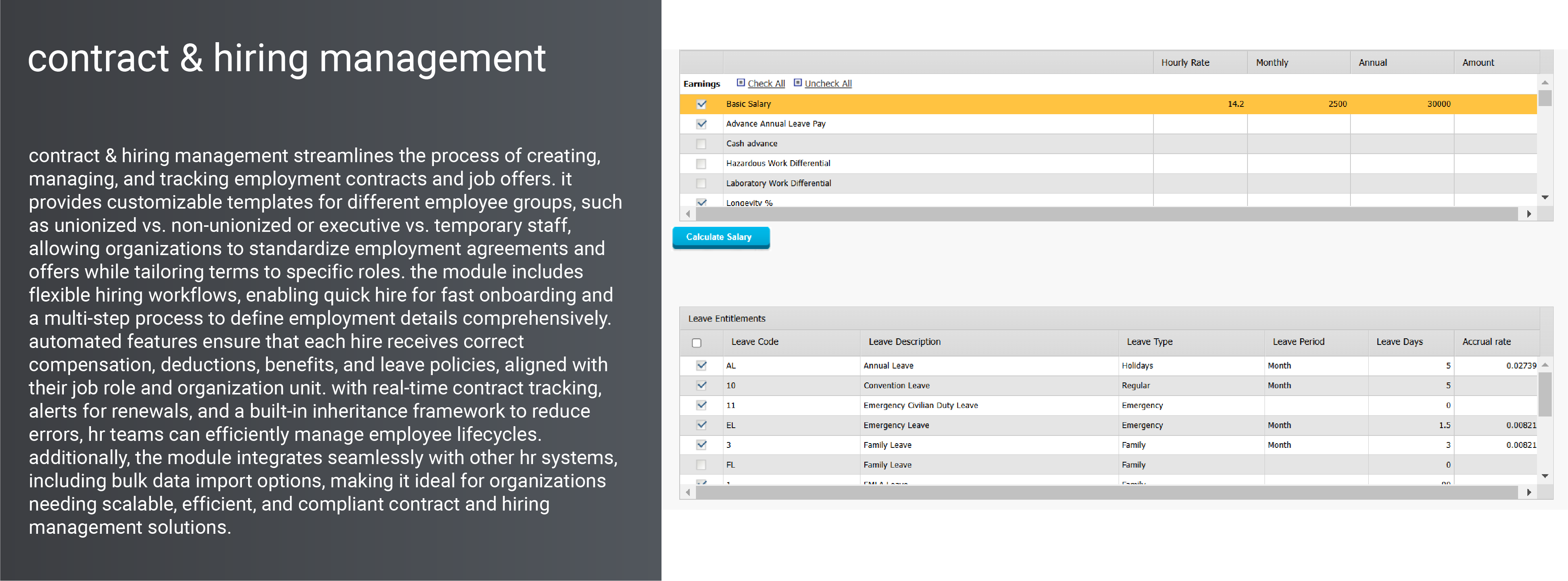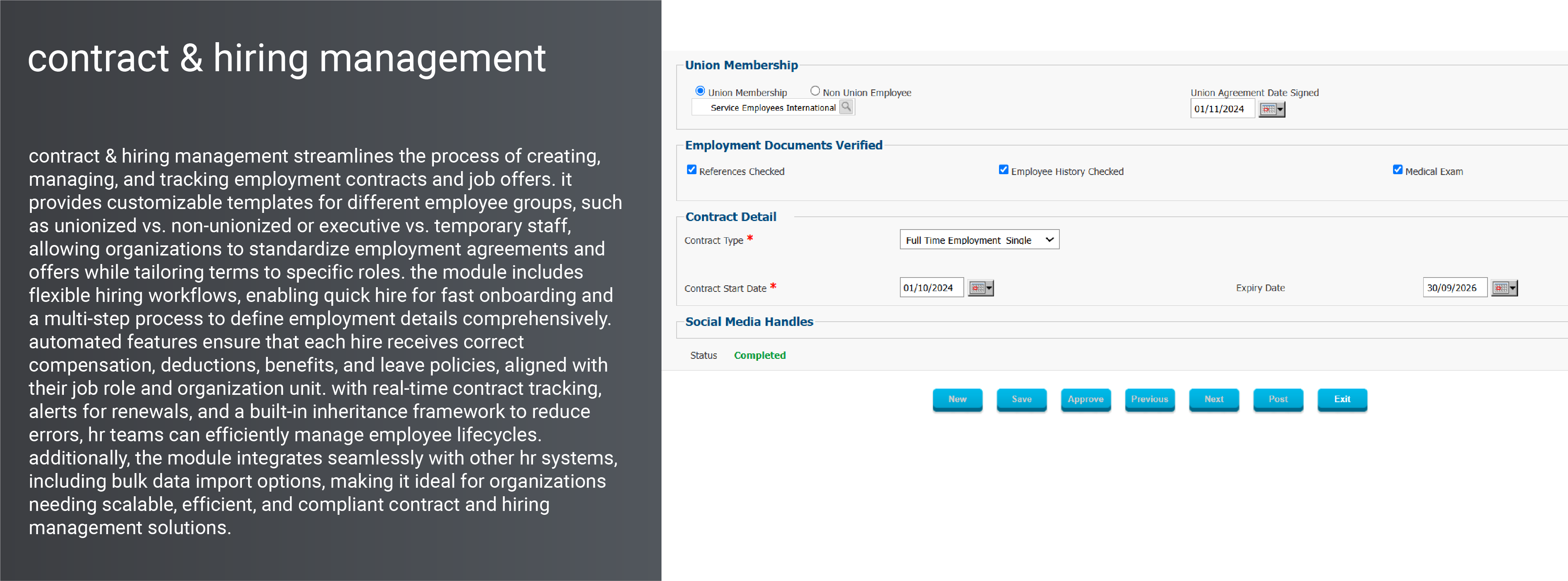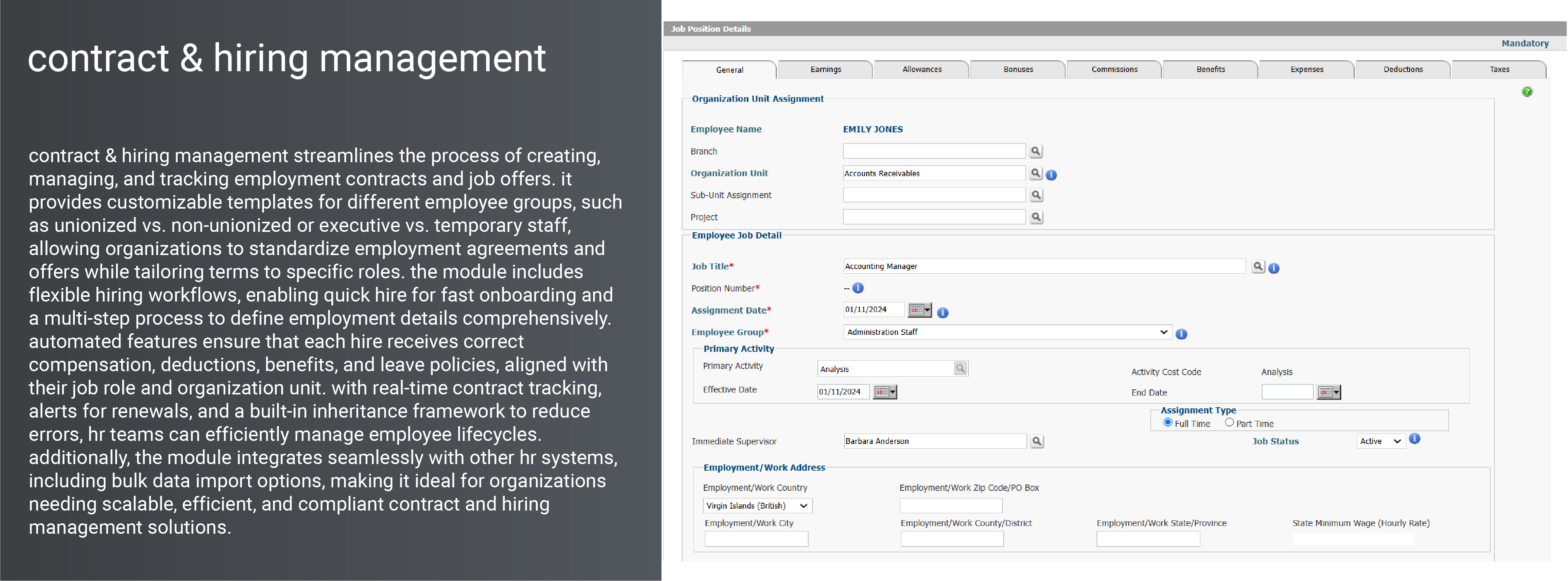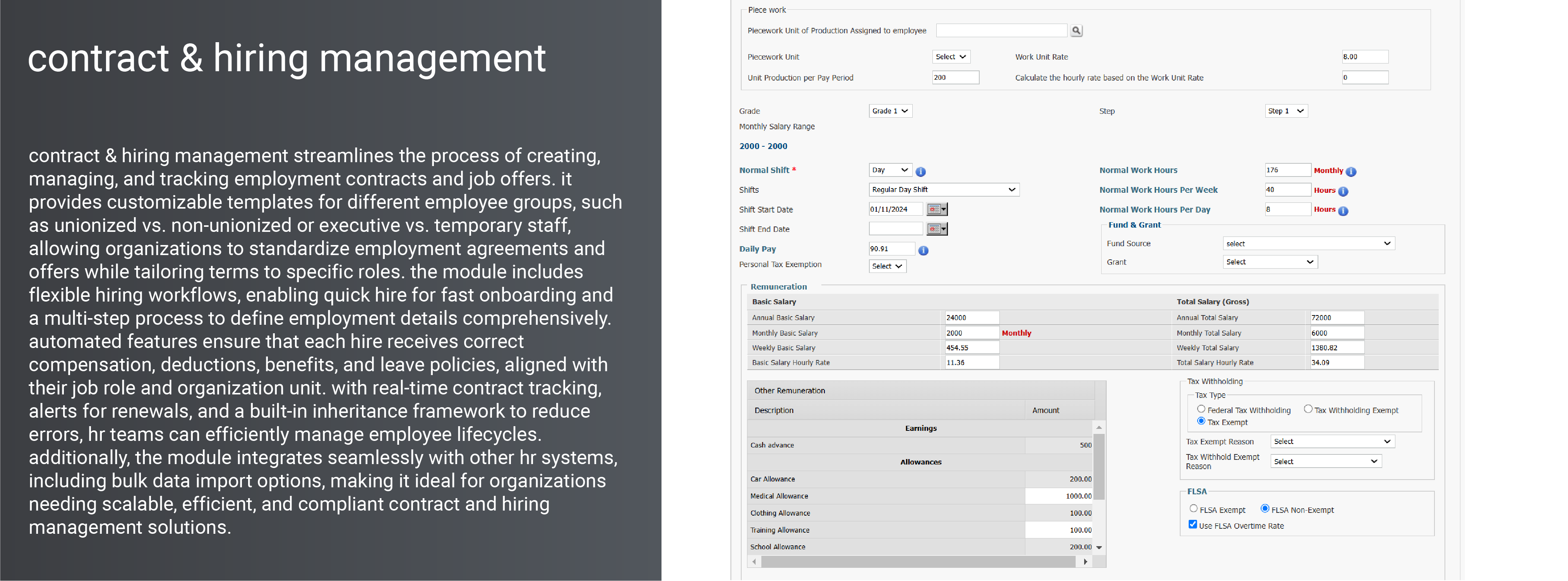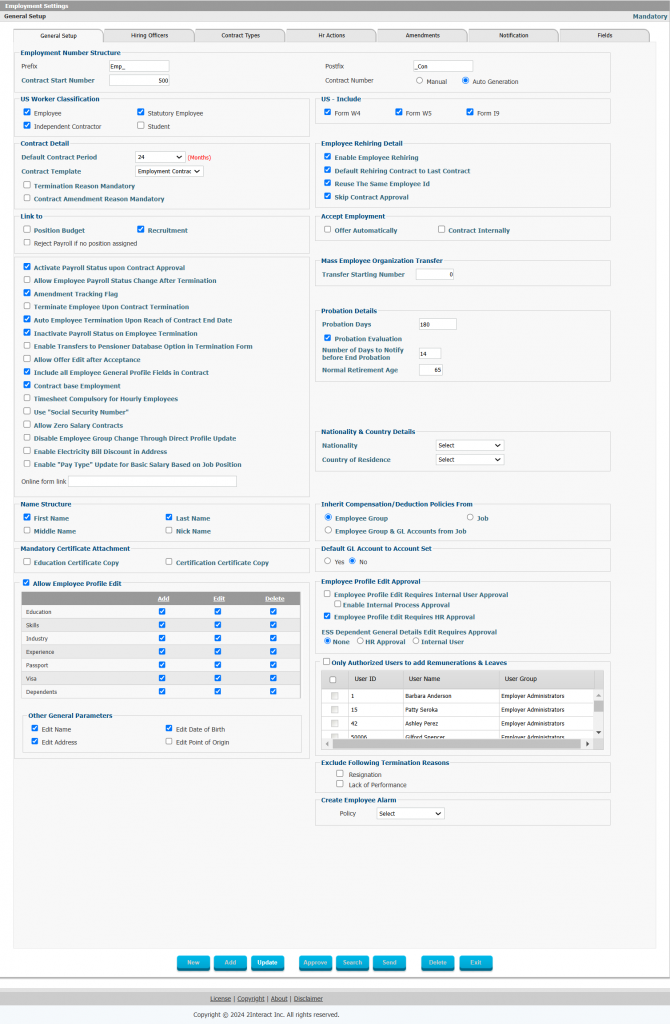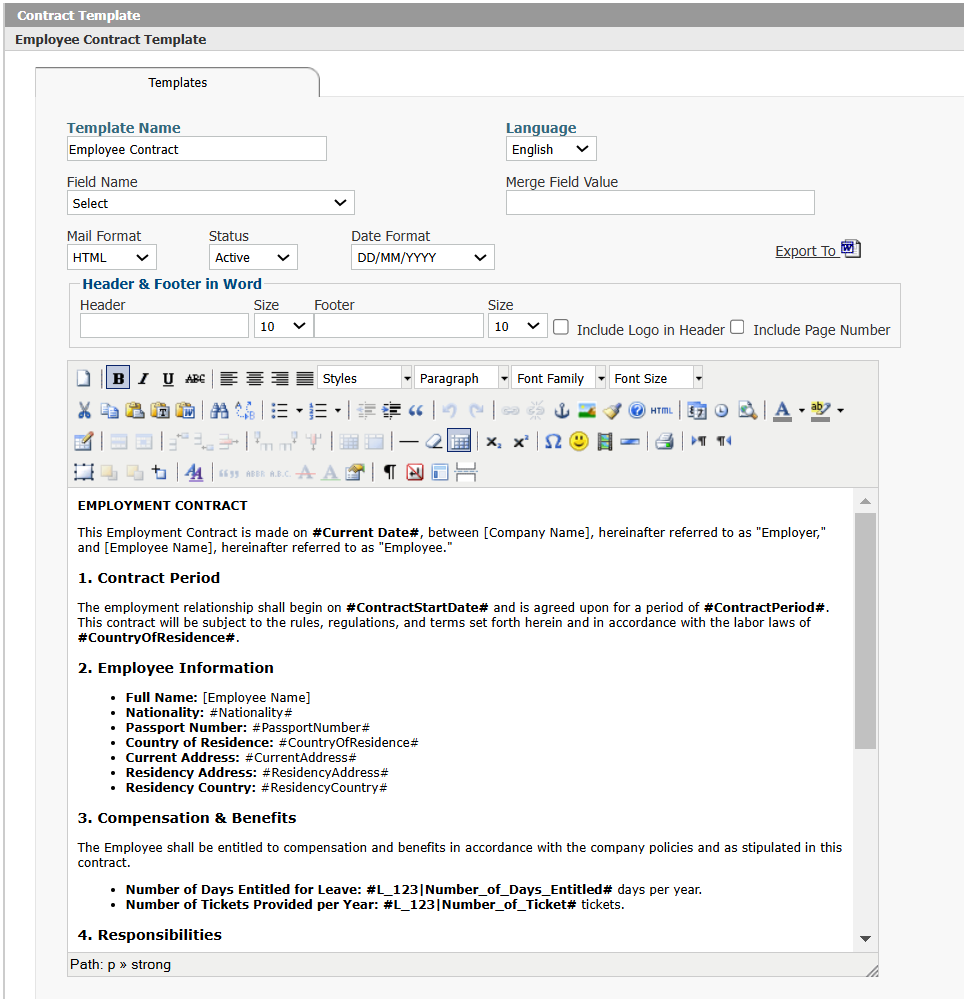Figure 1: Employment Setup
In order to have employee records in Interact HRMS, the employees will first need to be hired. Depending on the local labor laws and practices, some organizations may issue employment offers, possibly under at-will-employment rules, or work with employment agreements (contracts). Interact HRMS supports either method, allowing organizations to manage employment contracts, agreements, or offer letters for new hires. The Interact HRMS Contract & Hiring Management module delivers a robust solution for streamlined contract and hiring processes. This module is designed to simplify and enhance the hiring and contract management processes, allowing HR departments to create, issue, track, and manage employment agreements efficiently while tailoring these documents to meet specific organizational requirements. By enabling organizations to define templates, set default contract terms, and customize employment agreements, this module ensures that companies can handle the diverse hiring needs of various departments, job roles, and employee categories.
Comprehensive Contract Creation with Customizable Templates
One of the module’s key features is its ability to allow organizations to create employment contracts using predefined templates that can be customized for specific job roles, employee categories, or organizational units. With user-defined templates, HR teams can standardize employment contracts across the organization, reducing the time and effort needed to draft new agreements from scratch.
Companies that issue job offers instead of formal contracts can also benefit from this module’s Quick Hire functionality, which allows them to auto-generate job offers, simplifying the onboarding process for new hires. Whether an organization prefers to issue formal employment agreements or basic offer letters, this module provides the flexibility to adapt the document format and contents based on the company’s hiring policies.
Unlimited Employment Contract and Offer Templates
Figure 2: Employment Contract Template
To accommodate the variety of roles within an organization, the module allows HR managers to define unlimited templates for both employment offers and contracts. Each template can contain unique attributes, such as default contract duration, job-specific clauses, and benefits. The templates can be customized based on employee group (e.g., unionized vs. non-unionized employees), job category, or employment level (e.g., executive, full-time, temporary). For example, an organization may have one contract template tailored to executive-level employees and another designed for temporary staff.
This configuration helps ensure compliance with internal policies and external labor regulations, making it easier to issue contracts that reflect the specific needs of different employee groups. By tailoring contracts to specific roles, organizations can provide clarity for employees and set clear expectations regarding compensation, benefits, and work schedules from the start of employment.
Real-Time Contract Tracking and Expiry Notifications
The Contract & Hiring Management module also provides comprehensive tracking for all employment contracts, with alerts and notifications to help HR teams stay on top of contract expiry dates. The system allows users to monitor each contract’s lifecycle, including tracking any amendments made to the initial agreement. This feature ensures that organizations can address contract renewals or modifications proactively, helping to avoid lapses in employment agreements and potential disruptions to workforce planning.
With these alerts, HR managers receive timely reminders about upcoming contract expirations, allowing them to prepare renewal offers, amend terms, or initiate discussions with employees well in advance. This tracking capability is particularly valuable for organizations with high volumes of temporary or contract-based staff, where frequent renewals are required.
Flexible Hiring Process with Quick Hire and Multi-Step Options
The module offers flexible hiring workflows to accommodate various organizational needs. For rapid hiring, the Quick Hire feature enables HR staff to complete the hiring process with minimal input, perfect for situations where speed is essential. Alternatively, the New Employment Contract process provides a detailed, multi-step hiring workflow where HR teams can capture all relevant aspects of the employment relationship. In both cases, this process covers critical employment details, including:
– Assignment Date: When the employee is officially assigned to their new role.
– Hire Date: The date the employee is considered hired by the organization.
– Work Start Date: The official first working day for the employee.
– Job Title: The role for which the employee is being hired.
– Employee Group: The employee’s classification within the organization, such as part-time, full-time, or contract-based.
– Organization Unit: The department or business unit the employee will join.
– Compensation Elements: Base salary, bonuses, and all other compensatory factors.
– Probationary Period: Duration and terms of any initial probationary phase.
– Work Calendar and Shift Schedules: Specific days and hours of work, adjusted to each employee’s role and department needs.
With these capabilities, the module empowers organizations to gather all necessary employment details in a structured manner, setting up new hires for success from day one.
Automated Inheritance Framework for Consistency and Efficiency
The module works based on an Inheritance Framework that enhances efficiency and consistency during the hiring process. When hiring managers select an Employee Group and Organization Unit, the module automatically filters available options restricted to or associated with this employee group or organization unit, displaying only the Job Titles, Contract Types, Shifts, and other relevant fields applicable to the selected group or unit. It also automatically selects the applicable compensation, deduction, expenses and tax policies. This smart filtering minimizes the risk of errors and ensures that each new hire is correctly aligned with the policies and structures defined for their role.
This feature also helps streamline hiring for large organizations with complex structures by reducing the time required for HR staff to manually check and assign applicable job details.
Automated Assignment of Compensation Policies
Once the new hire’s details are entered, including the basic salary (potentially inherited from the Grade/Step associated with the job title if applicable), the system automates the assignment of compensation policies. This includes:
– Earnings: Basic salary and any additional earnings applicable to the role.
– Deductions: Applicable deductions based on employee group and organizational policies.
– Expenses: Reimbursable expenses, such as travel or equipment, depending on the employee’s role.
– Commissions and Bonuses: Additional compensation for roles eligible for performance-based pay.
– Benefits and Taxes: Company-provided benefits and any tax obligations based on the employee’s salary and employment terms.
The module’s automated compensation assignment ensures that employees are enrolled in all applicable policies and receive the correct compensation from day one, reducing the likelihood of payroll discrepancies and ensuring alignment with company policy.
Automated Leave Policy Assignment
In addition to compensation policies, the module assigns relevant leave policies based on the employee’s group and organizational unit. Whether the employee is entitled to specific vacation days, sick leave, or other time-off benefits, the system applies the correct leave policies automatically. This integration of leave management with the hiring process simplifies the onboarding workflow and ensures that employees have immediate access to their entitled leave from the start of employment. The hiring officer can then modify specific entitlements still at that moment before issuing the offer, if the employee’s particular leave policy entitlements should differ from the standard.
Importing Options for Mass Recruitment Efforts
The module also supports importing employee data via Excel, making it easy to onboard a large number of new hires quickly. This functionality is particularly beneficial for organizations that need to scale their workforce rapidly and wish to streamline data migration without manual data entry.
Summary: Interact HRMS Contract & Hiring Management
The Interact HRMS Contract & Hiring Management module delivers a comprehensive solution for organizations seeking to optimize their contract management and hiring processes. Key benefits include:
1. Customizable Employment Offer Templates: Create, modify, and manage unlimited employment offers and contract templates tailored to different job roles, departments, and employee groups.
2. Contract Tracking and Alerts: Monitor the full lifecycle of employment contracts with automatic alerts for expiration and tracking for amendments.
3. Flexible Hiring Options: Choose between Quick Hire for rapid onboarding or a detailed, multi-step hiring process for comprehensive employment setup.
4. Automated Inheritance and Compensation Policies: Reduce errors and save time with automatic assignment of job-specific attributes, compensation, and leave policies.
5. Seamless Integration and Data Import: Quickly hire new employees and import data from Excel for large-scale onboarding needs.
This module’s blend of customization, automation, and flexibility makes it a powerful tool for organizations looking to streamline their hiring and contract management processes, ensuring efficiency, compliance, and consistency across the workforce.


